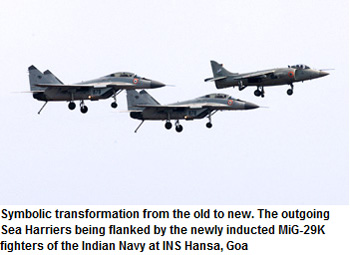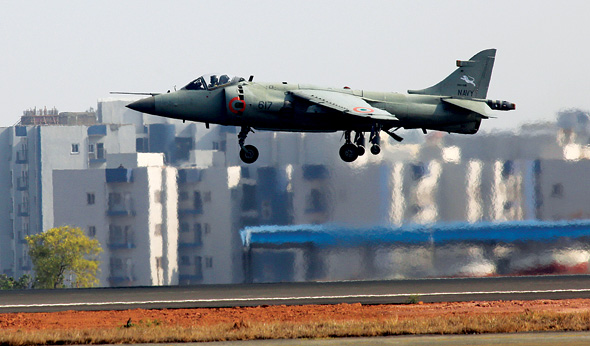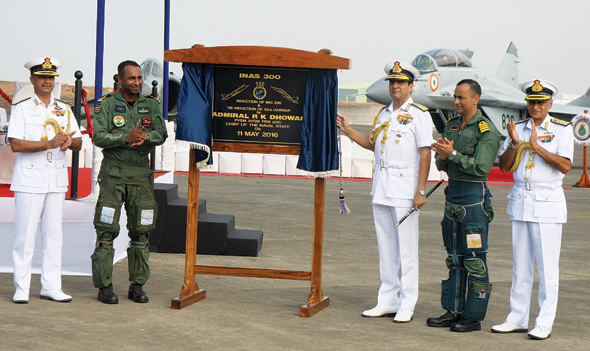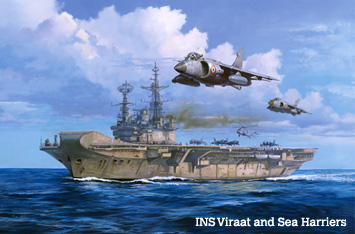INDIAN ARMED FORCES CHIEFS ON
OUR RELENTLESS AND FOCUSED PUBLISHING EFFORTS

SP Guide Publications puts forth a well compiled articulation of issues, pursuits and accomplishments of the Indian Army, over the years

I am confident that SP Guide Publications would continue to inform, inspire and influence.

My compliments to SP Guide Publications for informative and credible reportage on contemporary aerospace issues over the past six decades.
- Prime Minister witnesses 'Bharat Shakti' – a Tri-Services Firing and Manoeuvre Exercise in Pokhran, Rajasthan
- Interim Defence Budget 2024-25 — An Analysis
- Union Defence budget 2024
- Prime Minister Modi Commemorates Indian Navy Day in a Grand Ceremony
- Prime Minister Modi Flies in the LCA Tejas
- New Chapter in India-Italy Defence Ties
- Airpower beyond Boundaries
Sea Harriers fly away into glory

The illustrious and unique Sea Harriers of the Indian Naval Air Squadron (INAS) 300 were given a befitting farewell in a function organised at INS Hansa, Goa, on May 11, 2016. The function was attended by Admiral R.K. Dhowan, Chief of the Naval Staff (CNS), Vice Admiral Sunil Lanba, Flag Officer Commanding-in-Chief, Western Naval Command, serving and retired officers and men and all personnel who have served in the INAS 300. Speaking on the occasion CNS lauded the stellar role played by the squadron in the defence of the country and acknowledged the professionalism of the pilots, the maintainers and all those personnel associated with flying and maintaining the aircraft in peak efficiency during their service. He said that the rich legacy would continue as the baton is being passed on to the proud young crew of the MiG-29K Squadron who have been successful in seamlessly integrating the successor fighters with INS Vikramaditya in the shortest possible time.
In appreciation of the faithful service to the nation by INAS 300 ‘White Tigers’ an impressive ceremony was held which saw the Sea Harriers fly for one last time, and MiG-29K flanking their outgoing cousins and ceremoniously assuming the honourable position of the new generation successor fighters of the Indian Navy. The air display included supersonic pass by MiG-29K and formation flying by two each Sea Harriers and MiG 29Ks. The composite air display symbolised a smooth transition from the old to the new in continuance with the proud legacy of the INAS 300. On completion of the air display, “washing down of the Sea Harriers” was carried out in a traditional manner. A first day cover was also released by CNS to commemorate the occasion.
|
The White Tigers who stand for excellence, determination and aggressive spirit, heralded the era of carrier borne aviation into Indian Navy. Almost six decades ago the squadron was commissioned at RNAS Brawdy, UK with its distinctive ‘White Tiger’ logo and equipped with the Sea Hawk aircraft. After providing yeoman service for over two decades, the squadron was reincarnated with Sea Harriers in 1983. INAS 300 with its potent Sea Harriers formed the teeth of naval combat power and consequently was the centrepiece of naval operational strategy. With their professionalism, the White Tigers assured the control of areas of interest and emerged as a force to reckon with, by ensuring air dominance for Indian Navy’s Carrier Battle Group. Resultantly, Sea Harriers’ potent and lethal combat skills and dynamic manoeuvrability was appreciated globally, including the foreign navies as also the Indian Air Force.
At 0852 hours on Wednesday, May 11, 2016, Commander Shikku Raj, Commanding Officer, INAS 300, landed the Sea Harrier at INS Hansa, Goa, for the last time as he remembered the first time his father took him to see this incredible flying machine. It was in 1983, then Commander P.V. Rajan Pillai (now a retired naval veteran), was a member of the technical support team of INAS 300. On this occasion young Shikku Raj conjured a dream to fly the fighter aircraft one day. After his last sortie on May 11, 2016, Commander Shikku Raj recalled, “It was a moment of nostalgia. We took off at 0827 hours for the flypast along with MiG-29Ks. It was a short 25-minute exercise.” As he landed, he radioed the Air Traffic Controllers: “It’s been an honour. Thank you!” He continued, “It takes a lot from the pilot to just land. In every other aircraft, landing is second nature. In the Sea Harrier, you have to actually think how to land the aircraft, because it is so unconventional. Every recovery on the Sea Harrier in that respect is memorable.” A complex aircraft by every definition, the Sea Harrier, an otherwise brawny fighter jet, can hover like a helicopter, when required. Manufactured by British Aerospace, the Sea Harrier is a naval short/vertical take-off and landing (V/STOL) jet fighter, which uses four vector able nozzles for thrust.
One of the eminent guests at this ceremony was Admiral Arun Prakash (Retd), former Chief of the Naval Staff, an original Sea Hawk pilot who had earned the distinction of gallantry award of Vir Chakra during 1971 Indo-Pak war. Relevant to the context is his distinction of being the first IN pilot to be trained and converted to fly the Sea Harriers. He became the first Commanding Officer of INAS 300 (Sea Harriers) but not before the baptism by fire as during the intensive training phase he had to bail out of the Trainer Sea Harrier in a snow-bound area and suffered severe frostbites. For ferrying the brand new Sea Harriers he fought his way through convincing the authorities that the first set of aircraft are taken in fly-away condition. He successfully led the formation of first three Sea Harriers, flying all the way to India, via Malta, Luxor and Dubai. They landed at Dabolim, Goa, on December 16, 1983, to a jubilant welcome by the Indian Navy.
After witnessing the last sortie of the Sea Harrier when asked, Admiral Arun Prakash said, “I feel a mixture of nostalgia and happiness. We brought this aircraft and it has done a great service to the Indian Navy for 33 years. I miss flying. This time also I asked if they could give me a ride in the Harrier Trainer but they said no, you are too old. Not even a last ride, because the Ministry of Defence rules do not permit.”

The final flight of the Sea Harriers of INAS 300 still managed to enthrall the crowds at INS Hansa, Goa

MiG-29K undertaking tight turns to showcase its powers

Unveiling of plaque marking the deinduction of Sea Harriers and induction of MiG-29Ks in INAS 300

Admiral R.K. Dhowan releasing the first day cover on the ceremony of deinduction of
Sea Harriers and induction of MiG-29K in Goa





 Invited to witness the de-induction ceremony of Sea Harriers, Alistair Castle, Vice President and General Manager, India, BAE Systems commented, “We are very proud of our support to the Indian Navy in keeping the iconic Sea Harriers airworthy over the last 33 years. Three decades ago, when the Sea Harriers were inducted, these aircraft with modern weaponry, avionics and an engine which could land the aircraft vertically, defying all the laws of aerodynamics, introduced V/STOL for the Indian Navy. On this symbolic day, we rededicate ourselves to our partnership with the Indian Navy through our continued support on the Hawk advanced jet trainer.”
Invited to witness the de-induction ceremony of Sea Harriers, Alistair Castle, Vice President and General Manager, India, BAE Systems commented, “We are very proud of our support to the Indian Navy in keeping the iconic Sea Harriers airworthy over the last 33 years. Three decades ago, when the Sea Harriers were inducted, these aircraft with modern weaponry, avionics and an engine which could land the aircraft vertically, defying all the laws of aerodynamics, introduced V/STOL for the Indian Navy. On this symbolic day, we rededicate ourselves to our partnership with the Indian Navy through our continued support on the Hawk advanced jet trainer.”
